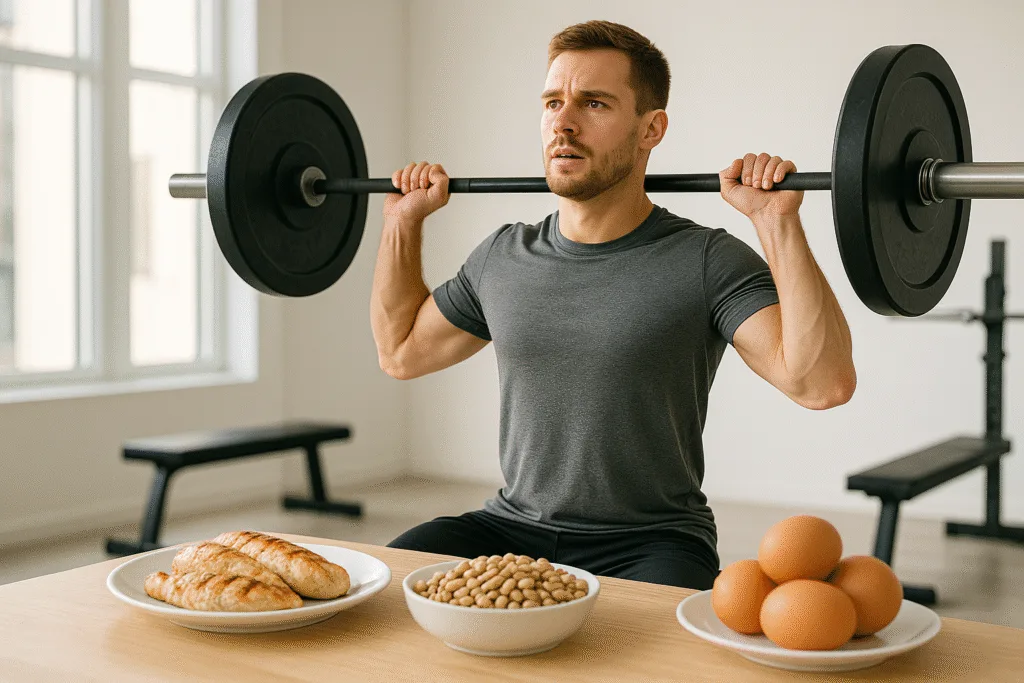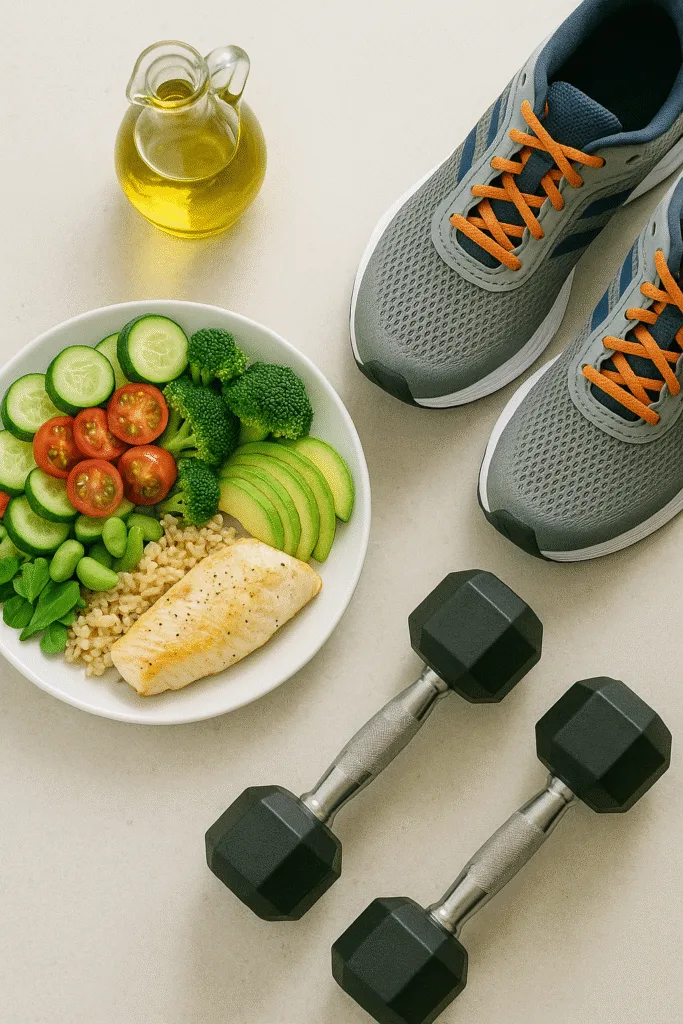Introduction
Most weight loss plans fail. Not because people don’t try, but because they follow programs built on hype instead of science.
Here’s the reality: the best workout and weight loss plans in 2025 are not flashy trends. They are programs tested in labs, gyms, and real life. They combine calorie control, strength training, cardio, and habit building.
In this guide, you’ll find the 10 most effective workout and weight loss plans backed by research. Each plan includes:
- Why it works.
- What the science says.
- Step-by-step instructions.
- Links to meal prep strategies, balanced diet plates, and intermittent fasting workouts.
This isn’t theory. These are the plans doctors, trainers, and researchers agree on.
1. High-Intensity Interval Training (HIIT) + Calorie Deficit

What It Is
HIIT alternates between short bursts of all-out effort and periods of rest or light activity. Example:
- 30 seconds sprint → 90 seconds walk → repeat 8–10 times.
Paired with a calorie deficit diet, it’s one of the fastest ways to lose fat.
Why It Works
- Burns more calories in less time.
- Increases EPOC (afterburn effect), so you keep burning calories after workouts.
- Preserves muscle while dropping fat.
What the Research Says
- A 2021 British Journal of Sports Medicine meta-analysis found that HIIT led to 28.5% greater fat loss compared to moderate-intensity exercise, when calories were controlled.
- Studies also show HIIT improves insulin sensitivity and cardiovascular fitness.
Step-by-Step Guide
- Warm up for 5 minutes (light jog, cycling).
- Sprint or go all-out for 20–30 seconds.
- Recover with walking or slow cycling for 60–90 seconds.
- Repeat for 15–20 minutes total.
- Do 2–3 sessions per week.
Pro Tips
- Start small: 4 rounds, build up to 8–10.
- Combine with Protein-Packed Balanced Plates for muscle support.
- Rest at least 48 hours between sessions.
Who Should Try This
- Busy professionals who want max results in minimal time.
- People without joint issues who can handle intense bursts.
- Anyone wanting both fat loss and cardio fitness.
2. Strength Training + High Protein Diet

What It Is
A plan that combines resistance training (weights, machines, or bodyweight) with a high protein intake. The goal is simple: lose fat while protecting muscle.
Strength training includes:
- Squats
- Deadlifts
- Push-ups
- Pull-ups
- Rows
Protein intake: 1.6–2.2 g per kg of body weight per day.
Why It Works
- Builds and preserves muscle mass.
- Increases metabolism (muscle burns calories at rest).
- Improves strength, posture, and overall health.
- Protein boosts satiety and reduces cravings.
What the Research Says
- A 2022 Frontiers in Nutrition review found higher-protein diets preserved lean mass during weight loss.
- A 2023 Sports Medicine meta-analysis confirmed strength training + protein intake led to greater fat loss and muscle retention compared to diet alone.
Step-by-Step Guide
- Train 3–4 days per week.
- Full-body sessions or push/pull/legs split.
- Focus on compound lifts (squats, deadlifts, presses, rows).
- Add accessory work (lunges, curls, planks).
- Eat protein at each meal:
- Breakfast: eggs or Greek yogurt.
- Lunch: chicken, beans, or fish.
- Dinner: lean meat, tofu, or lentils.
- Track intake with Protein-Packed Balanced Plate.
Pro Tips
- Progressive overload: add weight, reps, or sets over time.
- Rest 48 hours between working the same muscle group.
- Use whey protein shakes to fill gaps.
Who Should Try This
- Anyone serious about long-term fat loss.
- People who don’t want to “just lose weight” but also look toned.
- Beginners and advanced lifters alike.
Internal Boosters
- Get started with Push-Ups Per Day.
- Build habits with Power of Consistency in Fitness.
- Balance meals with Clean Meal Plates.
3. Zone 2 Cardio + Calorie Control

What It Is
Zone 2 cardio is steady-state exercise performed at 60–70% of your max heart rate. You can hold a conversation but feel slightly breathless.
Examples:
- Brisk walking
- Light jogging
- Cycling
- Swimming
Pair it with calorie control (moderate deficit of 500–750 kcal/day), and you have a powerful fat loss plan.
Why It Works
- Burns fat efficiently during exercise.
- Improves cardiovascular health and endurance.
- Easier to sustain than high-intensity workouts.
- When paired with a diet, it creates steady fat loss without burnout.
What the Research Says
- A 2021 Journal of Applied Physiology review showed Zone 2 training significantly improves mitochondrial health and fat oxidation.
- A 2023 study found people doing 150+ minutes of Zone 2 cardio weekly lost more fat than those doing sporadic HIIT, when diets were equal.
Step-by-Step Guide
- Calculate your Zone 2:
- Max HR = 220 − age.
- Zone 2 = 60–70% of Max HR.
- Pick your activity (walking, cycling, rowing).
- Train for 30–60 minutes per session.
- Do 3–5 sessions weekly.
- Pair with a calorie deficit. Use Meal Prep Strategies to stay consistent.
Pro Tips
- Use a smartwatch or HR monitor for accuracy.
- If short on time, break into 2×20-minute sessions per day.
- Combine with Balanced Diet Basics for sustainable results.
Who Should Try This
- Beginners who find HIIT too intense.
- People with joint issues who need lower impact workouts.
- Endurance athletes who want fat loss without losing stamina.
Internal Boosters
- Stay active all day: Stay Fit Without Working Out Daily.
- Support recovery with Healthy Juices and Smoothies.
4. Intermittent Fasting + Workouts

What It Is
Intermittent fasting (IF) is an eating pattern where you alternate between periods of eating and fasting. The most common style is 16:8—fast for 16 hours, eat within an 8-hour window.
When combined with workouts, especially strength training and cardio, IF can amplify fat loss while preserving muscle.
Why It Works
- Fasting windows often reduce total calories.
- Exercise in a fasted state increases fat oxidation.
- Training close to eating windows improves muscle recovery.
What the Research Says
- A 2020 Journal of Translational Medicine study found people doing strength training + IF lost more fat and maintained muscle compared to calorie restriction alone.
- A 2022 NEJM trial showed IF was equally effective as standard diets for weight loss, but adherence was higher in those who enjoyed the structure.
Step-by-Step Guide
- Choose your fasting style:
- 16:8 (most popular).
- 5:2 (two very low-calorie days per week).
- Alternate-day fasting (for advanced users).
- Time your workouts:
- Strength training: 1–2 hours before breaking the fast.
- Cardio: early morning or midday during the fasting window.
- Break your fast with a protein-rich meal to aid recovery.
- Stick to whole foods: lean protein, vegetables, whole grains, healthy fats.
Pro Tips
- Start with 12:12 and move up to 16:8.
- Stay hydrated: water, black coffee, tea during fasting.
- Use Intermittent Fasting Workout Guide for structured routines.
Who Should Try This
- Busy professionals who like clear rules.
- People who prefer larger meals in a shorter window.
- Anyone combining fat loss with muscle preservation.
Who Should Avoid It
- Pregnant or breastfeeding women.
- People with a history of eating disorders.
- Those with medical conditions unless cleared by a doctor.
Internal Boosters
- Balance nutrients with Clean Meal Plates.
- Avoid common mistakes: Don’t Do This Before Working Out.
- Stay consistent: Power of Consistency.
5. The Mediterranean Diet + Fitness Plan

What It Is
The Mediterranean diet isn’t just a way of eating. When paired with regular workouts, it becomes a sustainable weight loss and fitness lifestyle.
Core foods:
- Vegetables, fruits, legumes, and whole grains
- Olive oil, nuts, and seeds
- Fish and lean poultry
- Limited red meat and ultra-processed foods
Core workouts:
- Strength training 2–3 times per week
- Zone 2 cardio (brisk walking, cycling) 2–3 times per week
- Light activity daily (walking, stretching, chores)
Why It Works
- Nutrient-rich foods improve satiety without excess calories.
- Strong evidence for heart and metabolic health.
- Exercise pairing maximizes fat loss and preserves lean mass.
- High adherence: people stick with it longer than restrictive diets.
What the Research Says
- A 2023 JAMA Network Open trial found a reduced-calorie Mediterranean diet + exercise improved body composition more than diet alone.
- A 2024 BMC Nutrition review confirmed consistent weight loss and better blood pressure, blood sugar, and cholesterol outcomes.
Step-by-Step Guide
- Build meals around vegetables, lean protein, and olive oil.
- Add legumes or whole grains to each meal for fiber.
- Strength train 3 days per week (compound lifts, bodyweight moves).
- Do 150 minutes of Zone 2 cardio weekly.
- Add 7,000–10,000 steps daily.
Pro Tips
- Swap butter for olive oil.
- Use fish or beans for protein at least 3 times per week.
- Prep Mediterranean-style plates in advance: Clean Meal Plates.
Who Should Try This
- People who want weight loss and long-term health.
- Families or couples who want to eat together.
- Anyone tired of fad diets and extreme rules.
- Start with Mediterranean Diet Beginner’s Guide.
- Support with Healthy Juices and Smoothies.
- Add anti-aging benefits: Anti-Aging Foods and Remedies.
Internal Boosters
6. Low-Carb or Keto + Strength/Cardio Hybrid

What It Is
A plan that combines a low-carb or ketogenic diet with both strength training and cardio for rapid fat loss.
Low-carb: 50–150 g carbs per day.
Keto: <50 g carbs per day, with fat as the main fuel.
Workouts:
- Strength training 2–3 times per week (compound lifts, bodyweight).
- Zone 2 cardio 2 times per week.
- HIIT once per week for metabolic boost.
Why It Works
- Initial water loss + fat loss = fast results on the scale.
- Lower carbs reduce appetite for many people.
- Strength training prevents muscle loss.
- Cardio accelerates fat oxidation when carbs are low.
What the Research Says
- A 2020 BMJ meta-analysis found low-carb/keto diets produce faster fat loss at 6 months compared to low-fat diets.
- At 12 months, differences shrink—adherence is the deciding factor.
- A 2023 Nutrients review confirmed keto improves blood sugar control and short-term fat loss, but dropout rates are high.
Step-by-Step Guide
- Set protein: 1.6–2.0 g per kg body weight.
- Fill remaining calories with fat (avocado, nuts, olive oil, fatty fish).
- Train strength on Mon/Wed/Fri.
- Do Zone 2 cardio Tue/Thu.
- Add a short HIIT session Sat.
- Track progress weekly (weight + waist).
Pro Tips
- Transition slowly to avoid “keto flu.”
- Add electrolytes (sodium, magnesium, potassium).
- Use Protein-Packed Plates to keep meals balanced.
Who Should Try This
- People who want fast, visible results.
- Those with insulin resistance or high blood sugar.
- Individuals who enjoy high-fat foods and fewer carbs.
Who Should Avoid It
- Endurance athletes (need carbs for performance).
- People who struggle with restrictive diets.
- Anyone with kidney disease or medical concerns without clearance.
Internal Boosters
- Stay consistent: Power of Consistency.
- Support training recovery with Healthy Juices and Smoothies.
- Improve workout performance: Don’t Do This Before Working Out.
7. Walking + Daily Activity (NEAT Plan)

What It Is
NEAT = Non-Exercise Activity Thermogenesis. It’s the calories you burn outside of workouts. Walking, standing, cleaning, even fidgeting count.
This plan focuses on walking + daily activity as the foundation of fat loss. Add a small calorie deficit and you’ll see steady progress without intense workouts.
Why It Works
- Walking is low-impact and sustainable.
- Daily activity burns more calories than most realize.
- Reduces stress and improves sleep, which indirectly boosts fat loss.
- Easy to add to any lifestyle.
What the Research Says
- A 2022 Obesity study found people who walked 8,000–10,000 steps per day had lower body fat than those under 5,000, regardless of workouts.
- NEAT can account for 15–30% of daily calorie burn, sometimes more than workouts.
Step-by-Step Guide
- Set a step goal: start with 7,000–8,000, build to 10,000+.
- Add 10–15 minute walks after meals.
- Use stairs, stand at your desk, park farther away.
- Track steps with a smartwatch or phone.
- Pair walking with a modest calorie deficit using Balanced Diet Basics.
Pro Tips
- Break walks into short sessions (3×10 minutes).
- Listen to podcasts or audiobooks to stay consistent.
- Walk with friends or family for accountability.
Who Should Try This
- Beginners who feel intimidated by gyms.
- People with joint issues needing low-impact activity.
- Anyone who wants a long-term, no-equipment plan.
Internal Boosters
- Follow Stay Fit Without Daily Workouts.
- Add light strength with Push-Ups Per Day.
- Fuel energy with Healthy Juices and Smoothies.
8. Circuit Training + Calorie Cycling

What It Is
Circuit training combines strength and cardio in one session. You move from one exercise to the next with minimal rest, keeping your heart rate up.
Calorie cycling = eating slightly more calories on training days, fewer on rest days. This fuels workouts while maintaining a weekly deficit.
Example Circuit (repeat 3–4 rounds):
- Push-ups (12–15)
- Squats (15–20)
- Dumbbell rows (12–15)
- Jump rope (30 seconds)
- Plank (30–60 seconds)
Why It Works
- Burns calories fast by combining cardio + strength.
- Improves endurance and muscle tone at the same time.
- Calorie cycling keeps metabolism strong and workouts fueled.
- Breaks the monotony of traditional training.
What the Research Says
- A 2021 Journal of Strength and Conditioning Research study found circuit training produced similar fat loss to HIIT but with better muscle retention.
- A 2023 trial showed calorie cycling improved adherence and fat loss compared to constant calorie restriction.
Step-by-Step Guide
- Train circuits 3 days per week (Mon/Wed/Fri).
- Choose 5–6 exercises: mix strength and cardio.
- Perform 30–60 seconds per station, rest 30 seconds.
- Repeat 3–4 rounds.
- Calorie cycling:
- Training days: +200–300 calories (mainly carbs/protein).
- Rest days: −200–300 calories.
Pro Tips
- Keep workouts 30–40 minutes—short but intense.
- Use bodyweight if no equipment.
- Pair with Meal Prep Strategies to adjust meals for training/rest days.
Who Should Try This
- People bored with traditional workouts.
- Busy professionals who want strength + cardio in one session.
- Those who prefer short, high-energy sessions.
Internal Boosters
- Avoid mistakes: Don’t Do This Before Working Out.
- Support consistency: Power of Consistency.
- Balance nutrition with Clean Meal Plates.
9. Group Fitness & Social Accountability

What It Is
This plan focuses on using community and accountability to drive fat loss. Group fitness classes, partner workouts, and coaching sessions all create external motivation.
Examples:
- CrossFit
- Spin classes
- Bootcamps
- Small group strength training
- Even walking clubs
Why It Works
- Accountability keeps you showing up.
- Social support reduces dropout rates.
- Competition and encouragement push you harder.
- Builds consistency, which is the real key to weight loss.
What the Research Says
- A 2021 Journal of Social Sciences & Medicine review found people in group fitness programs had 55% higher adherence than solo exercisers.
- A 2022 Obesity trial showed group participants lost more weight over 12 months compared to those training alone.
Step-by-Step Guide
- Pick a group program (gym class, bootcamp, online challenge).
- Commit to 2–4 sessions per week.
- Pair with a nutrition plan you can follow (Mediterranean, high-protein, or IF).
- Add a partner or accountability buddy outside class for daily support.
Pro Tips
- Choose a program you enjoy—it matters more than the type.
- Track progress together with friends or teammates.
- Celebrate small wins as a group.
Who Should Try This
- People who struggle to stay motivated alone.
- Anyone who thrives in social environments.
- Beginners who want coaching built into workouts.
Internal Boosters
- Read: Benefits of Couple Workouts.
- Stay consistent with Power of Consistency.
- Add recovery support with Healthy Juices and Smoothies.
10. Lifestyle Integration Plan

What It Is
The Lifestyle Integration Plan isn’t a “diet” or a “workout.” It’s a system that combines nutrition, movement, sleep, and stress control into a single framework. Think of it as stacking all the proven habits into one routine.
Core pillars:
- Nutrition (balanced meals, calorie awareness).
- Training (strength + cardio).
- NEAT (daily movement).
- Sleep (7–9 hours).
- Stress management.
Why It Works
- Weight loss doesn’t come from one change—it comes from consistent daily actions.
- Integrating habits makes them automatic.
- Attacks fat loss from multiple angles: diet, exercise, recovery, and lifestyle.
What the Research Says
- A 2022 Lancet Public Health trial found programs that combined diet, exercise, and behavioral therapy led to 2–3× more weight loss than single-method approaches.
- A 2023 Nature Medicine review confirmed sleep and stress management amplify fat loss by controlling hunger hormones.
Step-by-Step Guide
- Nutrition:
- Follow Clean Meal Plates.
- Prep weekly: Meal Prep Strategies.
- Hit protein targets daily.
- Strength Training:
- 2–3 sessions per week (compound lifts, push-ups, squats).
- Progress gradually.
- Cardio:
- Zone 2 (walking, cycling) 150 minutes weekly.
- Optional HIIT once a week.
- NEAT:
- 8,000–10,000 steps daily.
- Walk after meals.
- Sleep & Stress:
- Consistent bedtime.
- Meditation, journaling, or light evening walks.
Pro Tips
- Stack habits: “After taking morning vitamins, I walk 10 minutes.”
- Use environment hacks: prep gym clothes at night, keep healthy snacks visible.
- Track 3 key metrics weekly: weight, waist, sleep hours.
Who Should Try This
- Anyone who’s tried multiple diets and failed.
- People ready for a full lifestyle shift.
- Those who want permanent, not temporary, fat loss.
Internal Boosters
- Build discipline with Power of Consistency.
- Avoid setbacks with Don’t Do This Before Working Out.
- Add natural recovery with Healthy Juices and Smoothies.
Conclusion
The best weight loss plans in 2025 aren’t fads. They are science-backed, flexible, and built for the long haul.
The top 10 plans are:
- HIIT + Calorie Deficit
- Strength Training + High Protein Diet
- Zone 2 Cardio + Calorie Control
- Intermittent Fasting + Workouts
- Mediterranean Diet + Fitness
- Low-Carb or Keto + Strength/Cardio Hybrid
- Walking + Daily Activity (NEAT)
- Circuit Training + Calorie Cycling
- Group Fitness & Accountability
- Lifestyle Integration Plan
The science is clear:
- Calorie control drives results.
- Strength training preserves muscle.
- Cardio improves health and fat burning.
- Sleep and stress matter as much as workouts.
- Consistency beats intensity every time.
Your next step: Don’t pick all 10. Pick one plan that fits your life. Stick with it for 12 weeks. Adjust when needed. Then stack habits for long-term success.
Weight loss isn’t about doing everything. It’s about doing the right things, consistently.

